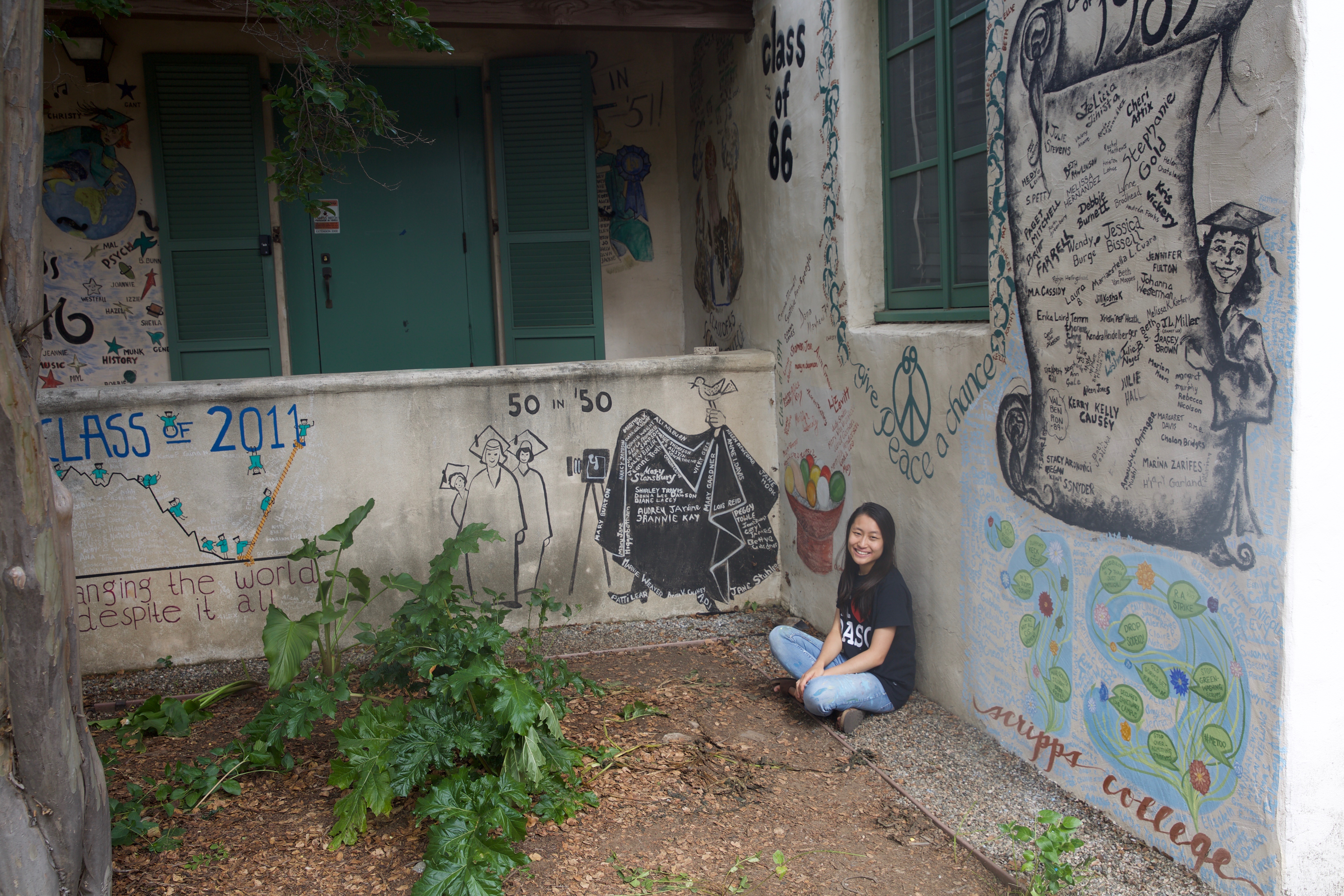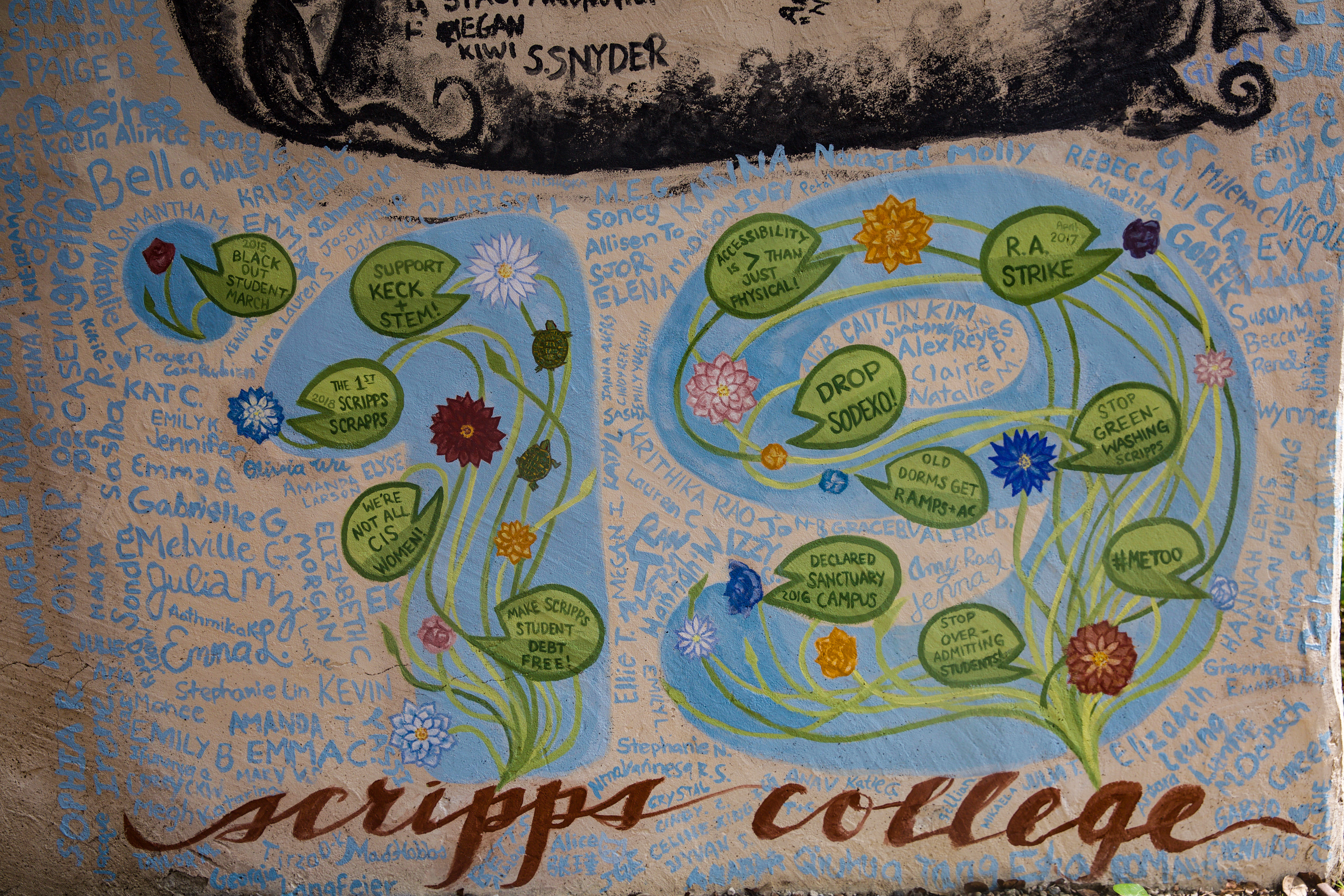
In one of the most enduring traditions at Scripps College, seniors leave their mark on campus by designing and signing an original mural on Graffiti Wall, adjacent to the Rose Garden. Spanning nearly a century, this rite of passage is a testament to the changing attitudes, concerns, and aesthetics of graduating classes.
Each year, a senior artist is selected by their classmates to design and paint the mural. Art major and computer science minor Alice Zhang ’19 is this year’s artist; her mural, an intricate web of lilies and lily pads, features a list of activist sentiments and events the graduating class encountered during their time at Scripps. Below, Zhang shares her inspiration for the mural and the message she wanted to convey to future Scripps generations.
Scripps College: What was the inspiration for the lilies and the lily pads?
Alice Zhang: My immediate inspiration was our beautiful campus. It’s hard to get 244 people to agree on any one thing, but surely everyone appreciates Seal Court and its fountain of water lilies! But that was only a starting point.
I recently read a paper that recontextualized water lilies as a feminist symbol. It fascinated me because water lilies have historically represented a union of femininity and fertility—a reinforcement of confining gender roles, so not the most empowering! However, the authors Gibson and Gagliano argued that water lilies actually defy those narrow connotations. Far from immobile, Nymphaeaceae are simultaneously grounded in mud and able to float across the water surface; their roots do not determine their position, but are instead a point of departure. Water lilies are also mobile across the gender spectrum; despite the cultural gendering of flowers as female, the flowers of water lilies are able to perform both male and female biological functions. Additionally, water lilies are able to create complex communities, signaling hormonally and chemically to report threats, adapt accordingly, and flourish. I also must mention that they’re not all pink and white—they come in all sorts of shapes, sizes, and colors, and they’re found in regions across the world; they even bloom at different times of night and day!
In these ways, water lilies seemed like an apt representation of our class. Just as Nymphaeaceae defy their traditional connotations, we are redefining what it means to go to a historically women’s college. Our identities and experiences are as varied as water lilies are diverse, and perhaps the only commonality I’m certain that we share is the place in which we have rooted ourselves: Scripps. And Scripps is ever evolving! That much is clear from the Graffiti Wall’s art over the years, and that is the inspiration for the lily pads. I wanted a mural that would inform future generations about our time. So, I designed the lily pads to look like chat bubbles describing what we’ve gone through. Like real water lilies, the painted ones of our mural are not silent; they communicate.
SC: How did you feel when your design was selected?
AZ: I was incredibly honored and honestly scared when selected as senior class artist. Scripps students have a reputation for being outspoken and passionate, and when something does not align with what we believe, we talk about it. And we don’t sugar coat. My mural was the most controversial of the nine design choices for this year because it was the only one that explicitly addressed campus events and concerns. I braced myself to hear a lot of criticism.

SC: Was it challenging trying to settle on a final design that felt representative of your whole class?
AZ: Yes! The lily pad text was difficult to finalize. I knew that not everyone would agree on what topics our mural should include, or what even our mural should do—what its purpose is. Shortly after being selected, I created a shared Google form where anyone could provide feedback on the proposed design, and I added, removed, and changed statements accordingly. Some people thought the lily pads were too critical, while others thought they weren’t critical enough. For a while, I considered removing the text altogether. But at the end of the day, I surveyed the Graffiti Wall murals that came before, and the ones that stood out to me the most were the ones that said something specific about their time at Scripps—they showed how Scripps has changed and how students have often been catalysts for that change. That really made me think about who our mural is for—we may be signing it, but we are also graduating, so we will rarely see our own mural. Ironically, the content holds more significance for later class years than for us. So, I kept the text, and I gave it a stronger emphasis on campus activism. I want to leave a legacy that shows all of the amazing work that our class did, while showing future generations that there is still much to be done.
View a time-lapse video of the Class of 2019 signing the mural below.

